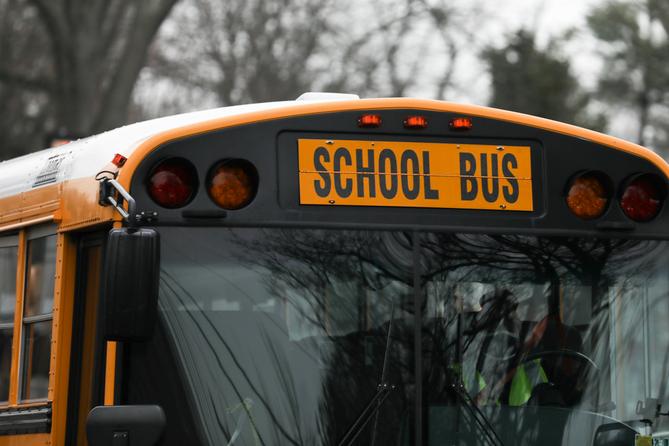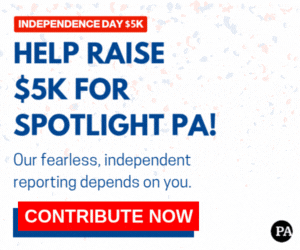Spotlight PA is an independent, nonpartisan newsroom powered by The Philadelphia Inquirer in partnership with PennLive/The Patriot-News, TribLIVE/Pittsburgh Tribune-Review, and WITF Public Media. Sign up for our free newsletters.
HARRISBURG — Private school vouchers are shaping up to be the key sticking point of this year’s Pennsylvania budget negotiation, with Republicans and Democratic Gov. Josh Shapiro vocally supporting them and the Democrats who narrowly control the state House digging in their heels in opposition.
The voucher proposal on the table is known as the Pennsylvania Award for Student Success (or PASS) scholarship program.
It would give between $2,500 and $15,000 per year in state-funded vouchers to eligible students, depending on grade and whether the student needed special education services. That money could be used only for tuition at a nonpublic school, or on associated fees, including special education expenses.
This kind of program is often framed as being about school choice, a name for an education movement that typically asserts taxpayer dollars should flow to students and their families, not to public educational institutions.
But school choice is much bigger than just vouchers, and it’s also a politically complicated movement. Here’s the context you should know about this year’s biggest budget fight:
Last updated: June 30, 12 p.m.
What is school choice?
School choice is a broad term, but the educational programs that tend to fit under its umbrella usually have at least one thing in common: seeking to use taxpayer dollars to make available a range of educational opportunities at little or no cost, rather than funding only public schools.
Some school choice options exist within or alongside the public school system.
These include open enrollment policies, in which students can attend any public school regardless of location; magnet schools, which are public schools that specialize in certain subjects; and charter schools, which are publicly funded but operate independently of districts.
States may also provide financial assistance to parents who pursue private school options through tax credits or school choice vouchers, which allow public school students to use public funds to attend private schools.
These kinds of measures — and vouchers in particular — are especially contentious in Pennsylvania.
Vouchers have long been a top priority for Republican lawmakers in Harrisburg, and some Democrats are also in favor of the program. This group includes state Sen. Anthony Williams, (D., Philadelphia) who described Harrisburg’s debate over school choice as “a false narrative to pit the choice folks against the public school folks.”
“If you have a school in your district, a public school, that is not educating children, that is not safe, you shouldn’t be required to send your children there just because of your socioeconomic status,” he said. “That is just not fair.”
Williams said he happily voted for many budgets over the past eight years that increased public school funding, including for low-achieving schools in his district, which is predominantly based in West Philadelphia. “Unfortunately, many schools in my district have not increased their performance. In fact, their performance went down,” he said.
But other Democrats strongly disagree and have argued it’s not possible for a healthy public education system to exist alongside a voucher program. Teachers’ unions also take this stance.
Rich Askey, the president of the Pennsylvania State Education Association, said even though Shapiro has said he won’t support a voucher program that takes away money from public schools, Askey doesn’t buy the argument.
“There is absolutely no way to create a tuition voucher program that doesn’t take money away from public schools,” Askey said. “Our public school students don’t have a moment to waste on this nonsense. Now let’s get to work on passing a budget that supports them and our public schools.”
What are the Educational Improvement and Opportunity Scholarship Tax Credit programs?
Currently, Pennsylvania’s biggest statewide school choice programs are a pair of tax credits — the Educational Improvement Tax Credit (EITC) and the Opportunity Scholarship Tax Credit (OSTC).
EITC provides tax breaks to corporations that contribute money to nonprofits so they can fund private school scholarships, or so they can pay for “innovative” programs in public schools.
The OSTC program is similar, but is specifically geared toward students in low-achieving schools. Only students who attend a school that ranks in the bottom 15% of schools of its kind qualify for the scholarships OSTC funds.
Both credits are worth 75% to 90% of the value of the contribution a company contributes, and the maximum tax credit is $750,000 per company. Credits are awarded to companies on a first-come, first-served basis until the state’s cap on the program is reached. Last year’s budget had EITC capped at $340 million and OSTC capped at $125 million.
Students are eligible for EITC scholarships if their annual household income does not exceed $105,183, plus $18,514 for each child in the family for the 2022-23 school year. OSTC eligibility guidelines are the same, with the added caveat that a student must attend a low-achieving school. The average scholarship value was $2,554 in the 2021-22 school year, the most recent year for which that data is available.
Supporters, who are largely Republican, typically attempt to grow the program each budget cycle. They face opposition from Democrats who worry they will weaken public schools by cutting state funding and funneling it to private schools, which do not require funding from the state.
How is the voucher proposal different?
On the table this year is a voucher program for students that would route state money directly into private schools rather than providing a tax credit to scholarship funders.
In recent years, voucher programs have become increasingly popular across the country.
The idea gained traction in Pennsylvania last legislative session when state Sen. Judy Ward (R., Blair) introduced a bill to create so-called lifeline scholarships. It didn’t pass then, but Ward reintroduced it this year with tweaks.
“This legislation will give more children attending low-performing school districts the opportunity to attend school that better meets their needs,” Ward wrote in a memo to senators.
The state Senate has not considered Ward’s bill. Instead, chamber leadership used it as a starting point to negotiate with Shapiro. Those talks resulted in a new version of the program, which senators amended into a different bill this week and approved.
Instead of lifeline scholarships, the new measure — which passed the state Senate 29-21 on Thursday — would create the Pennsylvania Award for Student Success (or PASS) program. Many of the fundamentals are the same as Ward’s original proposal.
Voucher money would be available only to students who attend low-achieving public schools.
Parents with children enrolled in one of these schools would be notified annually that they are eligible for the scholarship. Qualifying students who apply would be picked on a first-come, first-served basis, and would be able to only use the scholarship money for tuition at a private school, related fees, or special education fees at a private school.
The bill would provide $2,500 in annual grants for students in half-day kindergarten, $5,000 for students attending full-day kindergarten through eighth grade, and $10,000 for high school students. Students who require special education services would qualify for up to $15,000 annually.
Unlike Ward’s bill, the new measure restricts participation to children whose families make less than 250% of the federal poverty guidelines. A family of four, for instance, would have to make less than $75,000 annually to qualify.
It also puts a price tag of $100 million on the program with future increases tied to bumps in the state’s public education budget.
Ward’s original proposal last session would have taken state funds directly from the public school district that the student is leaving. But her reworked measure — as well as the newest voucher pitch that Shapiro and state Senate Republicans negotiated — would be funded via the state’s income tax revenue.
The state would begin awarding scholarships in the 2024-25 school year. Preference would be given in subsequent years to children who had already received a scholarship.
Who supports vouchers? Who doesn’t?
As with school choice generally, the political debate over vouchers doesn’t cleanly break down along partisan lines.
Republican lawmakers largely support the scholarships, arguing that they provide parents with important control over their children’s education. Democrats often oppose them, saying vouchers diminish public schools and would take away funding for already struggling districts in low-income areas.
But the commonwealth’s top Democrat, Shapiro, supported vouchers on the campaign trail and has since reiterated his support during budget negotiations, reinvigorating supporters’ advocacy.
“I believe every child of God deserves a shot here in the Commonwealth of Pennsylvania,” Shapiro said in an interview with Fox News in June. “One of the best ways we can guarantee their success is making sure every child has a quality education.”
Shapiro has clarified that he would only support vouchers and school choice programs that do not cut into funding for public schools. That condition is seen as a key reason why Ward adjusted her bill this session to fund the program from the budget, rather than as a share of districts’ funding.
The governor’s stance on vouchers has resulted in intense backlash from teachers’ unions, labor unions generally, and public education advocates who argue the programs would harm public education funding.
Last week, a broad coalition of labor groups that included the state education association Council 13 of AFSCME; and Local 1776 of the United Food and Commercial Workers union sent Shapiro and Secretary of Education Khalid Mumin a letter highlighting their disapproval of any effort to fund lifeline scholarships.
“It is clearly irresponsible to appropriate state funds for tuition vouchers that benefit private and religious schools when the commonwealth hasn’t met its most basic duty to students who attend our public schools — the same public schools that the Commonwealth Court has determined are unconstitutionally underfunded,” the coalition wrote.
Voucher advocates, meanwhile, maintain the opposite. Nathan Benefield, senior vice president of the Commonwealth Foundation, a free-market think tank, argued the program would benefit public schools.
The latest proposal, he said, is designed to operate using new state funding, not funding taken from the existing public education budget.
“This doesn’t take a single cent from public school funding and in fact, it helps public schools,” Benefield said. “Public schools will have the same amount of funding even when a student leaves and there have been dozens and dozens of studies on the effects of these programs and almost in all cases find that educational choice has been better.”
Lawmakers and Shapiro’s administration have a deadline of midnight on June 30 to approve a spending plan and decide whether or not it will include vouchers.
It’s possible, however, that conflict could contribute to them blowing that deadline, which means negotiations could stretch days, weeks, or months into the summer.
Samuel O’Neal is an intern with the Pennsylvania Legislative Correspondents’ Association. Learn more about the program. Spotlight PA is funded by foundations and readers like you who are committed to accountability journalism that gets results.

